High resistance materials, high resistance alloys
For the creation of rheostats, the manufacture of precision resistors, the manufacture of electric furnaces and various electric heating devices, conductors of materials with high resistance and low temperature coefficient of resistance.
These materials in the form of ribbons and wires should preferably have a resistance of 0.42 to 0.52 ohms * sq.mm / m. These materials include alloys based on nickel, copper, manganese and some other metals. Mercury deserves special attention, since mercury in its pure form has a resistance of 0.94 ohm * sq.mm / m.
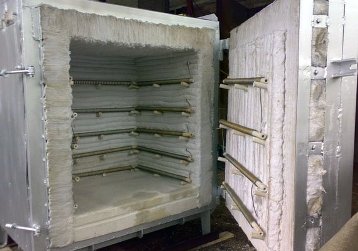
The characteristic properties required of alloys on an individual basis are determined by the specific purpose of a particular device in which that alloy will be used.
For example, the creation of accurate resistors requires alloys with low thermoelectricity induced by contact of the alloy with copper. The resistance should also remain constant over time.In furnaces and electric heaters, oxidation of the alloy is unacceptable even at temperatures from 800 to 1100 ° C, that is, heat-resistant alloys are needed here.
All these materials have one thing in common — they are all high resistivity alloys, which is why these alloys are called high electrical resistivity alloys. Materials with high electrical resistance in this context are solutions of metals and have a chaotic structure, which is why they meet the requirements for themselves.
Manganin
Manganins are traditionally used for precision resistance. Manganins are composed of nickel, copper and manganese. Copper in the composition — from 84 to 86%, manganese — from 11 to 13%, nickel — from 2 to 3%. The most popular of the manganins today contains 86% copper, 12% manganese and 2% nickel.
To stabilize manganins, a little iron, silver and aluminum are added to them: aluminum — from 0.2 to 0.5%, iron — from 0.2 to 0.5%, silver — 0.1%. Manganins have a characteristic light orange color, their average density is 8.4 g / cm3, and their melting point is 960 ° C.
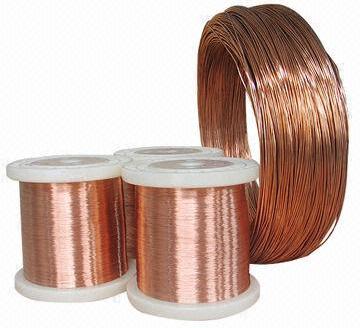
Manganese wire with a diameter of 0.02 to 6 mm (or a strip 0.09 mm thick) is either hard or soft. Annealed soft wire has a tensile strength of 45 to 50 kg / mm2, elongation is from 10 to 20%, resistance is from 0.42 to 0.52 ohm * mm / m.
Characteristics of solid wire: tensile strength from 50 to 60 kg / sq.mm, elongation - from 5 to 9%, resistance - 0.43 - 0.53 ohm * sq.mm / m. The temperature coefficient of manganin wires or tapes varies from 3 * 10-5 to 5 * 10-5 1 / ° С, and for stabilized - up to 1.5 * 10-5 1 / ° С.
These characteristics show that the temperature dependence of the electrical resistance of manganin is extremely insignificant, and this is a factor in favor of the constancy of the resistance, which is very important for precision electrical measuring devices. The low thermo-emf is another advantage of manganin, and in contact with copper elements it will not exceed 0.000001 volts per degree.
In order to stabilize the electrical characteristics of the manganin wire, it is heated under vacuum to 400 ° C and kept at this temperature for 1 to 2 hours. The wire is then kept at room temperature for a long time to achieve an acceptable uniformity of the alloy and obtain stable properties.
Under normal operating conditions, such a wire can be used at temperatures up to 200 ° C — for stabilized manganin and up to 60 ° C — for unstabilized manganin, since unstabilized manganin, when heated from 60 ° C and above, will undergo irreversible changes. which will affect its properties ... So it is better not to heat unstabilized manganin up to 60 ° C, and this temperature should be considered the maximum permissible.
Today, the industry produces both bare manganese wire and wire in enamel insulation with high strength - for the manufacture of coils, in silk insulation and in two-layer mylar insulation.
Constantan
Constantan, unlike manganin, contains more nickel — from 39 to 41%, less copper — 60-65%, significantly less manganese — 1-2% — it is also a copper-nickel alloy. The temperature coefficient of resistance of constantan approaches zero — this is the main advantage of this alloy.
Constantan has a characteristic silver-white color, melting point 1270 ° C, density on average about 8.9 g / cm3.The industry produces constantan wire with a diameter of 0.02 to 5 mm.
The annealed soft constantan wire has a tensile strength of 45 — 65 kg / sq.mm, its resistance is from 0.46 to 0.48 ohm * sq.mm / m. For hard constantan wire: tensile strength — from 65 to 70 kg / sq.mm, resistance — from 0.48 to 0.52 Ohm * sq.mm / m. The thermoelectricity of constantan connected to copper is 0.000039 volts per degree, which limits the use of constantan in the manufacture of precision resistors and electrical measuring instruments.
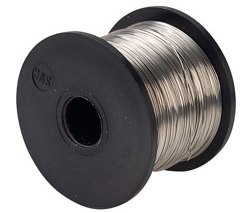
Significant, compared to manganin, thermo-EMF allows the use of constantan wire in thermocouples (paired with copper) to measure temperatures up to 300 ° C. At temperatures above 300 ° C copper will begin to oxidize, while it should be noted , that constantan will start to oxidize only at 500 °C.
The industry produces both constantan wire without insulation and winding wire with high-strength enamel insulation, wire in two-layer silk insulation and wire in combined insulation - one layer of enamel and one layer of silk or lavsan.
In rheostats, where the voltage between adjacent turns does not exceed a few volts, the following property of a permanent wire is used: if the wire is heated to 900 ° C for a few seconds and then cooled in air, the wire will be covered with a dark gray oxide film. this film can serve as a kind of insulation, since it has dielectric properties.
Heat resistant alloys
In electric heaters and resistance furnaces, the heating elements in the form of ribbons and wires must be able to operate for long periods of time at temperatures up to 1200 °C.Neither copper, nor aluminum, nor constantan, nor manganin are suitable for this, because from 300 ° C they already begin to oxidize strongly, the oxide films then evaporate and the oxidation continues. Heat-resistant wires are needed here.
Heat-resistant wires with high resistance, also resistant to oxidation when heated and with a low temperature coefficient of resistance. This is just about nichrome and ferronichromes—binary alloys of nickel and chromium and ternary alloys of nickel, chromium, and iron.
There are also fechral and chromal-triple alloys of iron, aluminum and chromium — they, depending on the percentage of components included in the alloy, differ in electrical parameters and heat resistance. All these are solid solutions of metals with a chaotic structure.
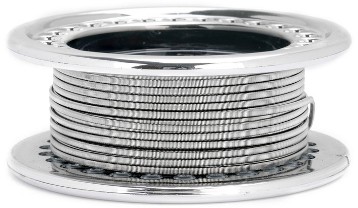
Heating these heat-resistant alloys leads to the formation on their surface of a thick protective film of chromium and nickel oxides, resistant to high temperatures up to 1100 ° C, reliably protecting these alloys from further reaction with atmospheric oxygen. So the tapes and wires of heat-resistant alloys can work for a long time at high temperatures, even in air.
In addition to the main components, alloys include: carbon — from 0.06 to 0.15%, silicon — from 0.5 to 1.2%, manganese — from 0.7 to 1.5%, phosphorus — 0.35 %, sulfur — 0.03%.
In this case, phosphorus, sulfur and carbon are harmful impurities that increase brittleness, therefore their content is always sought to be minimized or better to be completely eliminated. Manganese and silicon contribute to deoxidation, removing oxygen. Nickel, chromium and aluminum, especially chromium, help provide resistance to temperatures up to 1200°C.
The alloy components serve to increase the resistance and decrease the temperature coefficient of resistance, which is exactly what is needed from these alloys. If the chromium is more than 30%, then the alloy will turn out to be brittle and hard. To obtain a thin wire, for example, 20 microns in diameter, no more than 20% chromium is needed in the composition of the alloy.
These requirements are met by alloys of the Х20Н80 and Х15Н60 brands. The remaining alloys are suitable for the production of strips with a thickness of 0.2 mm and wires with a diameter of 0.2 mm.
Alloys of the Fechral type — X13104, contain iron, which makes them cheaper, but after several heating cycles they become brittle, therefore during maintenance it is unacceptable to deform the chromal and fechral spirals in a cooled state, for example, if we they talk about a spiral that works for a long time in the heating device. For repair, only a spiral heated to 300-400 ° C should be twisted or spliced. In general, fechral can operate at temperatures up to 850 °C, and chromal - up to 1200 °C.
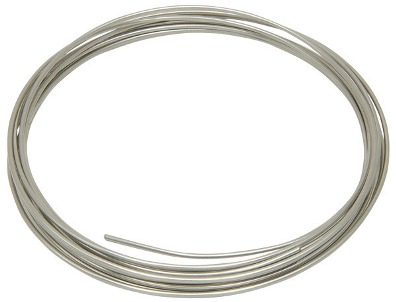
Nichrome heating elements, in turn, are designed for continuous operation at temperatures up to 1100 ° C in stationary, slightly dynamic modes, while they will not lose either strength or plasticity. But if the mode is sharply dynamic, that is, the temperature will change dramatically many times, with frequent switching on and off of the current through the coil, the protective oxide films will crack, oxygen will penetrate the nichrome, and the element will eventually oxidize and destroy.
The industry produces both bare wires made of heat-resistant alloys, and wires insulated with enamel and silicon silicon varnish, intended for the production of coils.
mercury
Mercury deserves a special mention because it is the only metal that remains liquid at room temperature. The oxidation temperature of mercury is 356.9 ° C, mercury almost does not interact with air gases. Solutions of acids (sulfuric, hydrochloric) and alkalis do not affect mercury, but it is soluble in concentrated acids (sulfuric, hydrochloric, nitric). Zinc, nickel, silver, copper, lead, tin, gold dissolve in mercury.
The density of mercury is 13.55 g / cm3, the transition temperature from liquid to solid state is -39 ° C, the specific resistance is from 0.94 to 0.95 ohm * sq.mm / m, the temperature coefficient of resistance is 0 ,000990 1 / ° C ... These properties make it possible to use mercury as liquid conductive contacts for special purpose switches and relays, as well as in mercury rectifiers. It is important to remember that mercury is extremely toxic.
